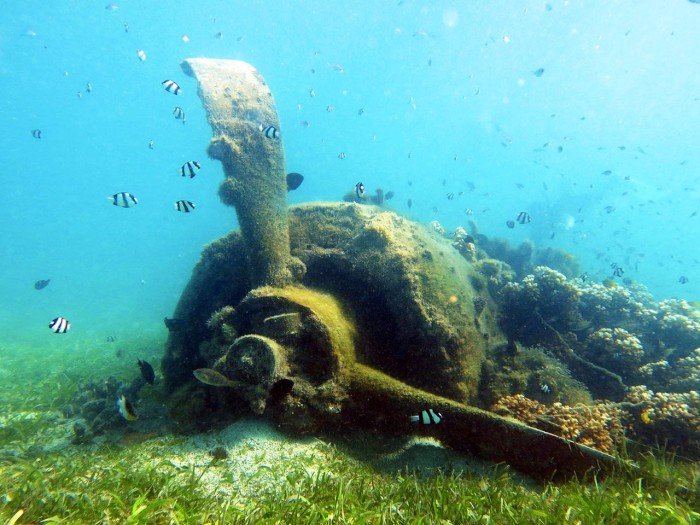Panapompom in the Deboyne Islands Atoll
18 September 2018

Next stop was the island of Panapompom. Calm anchorage in about 8 m behind Nivani Island with only a few bommies to avoid coming in (thank goodness - as I was feeling somewhat anxious about any coral reefs).
Upon arrival, Mallie paddled out to welcome us to his village. Although there is no formal chief system, he appears to be the respected informal elder of the island. His son, Ishmael, is the formal representative, being the island's councillor who sits on the local government body. Mallie's other son Toby and his wife Ellse, I considered being the 'yuppies' of the village. They have a house built of wood, (built to plans drafted by a passing yachtsman), plus pigs, chickens and do you believe, a whipper snipper to keep the grass down! We were pleasantly surprised when Noino, another brother, paddled out and gave us a magnificent handcrafted wooden plaque he had made for Far Star.
The people on this island, appear to live a higher standard of living compared to Panasia, probably due to the opportunity to earn cash and a greater number of inhabitants, which seem to attract government services. This includes facilities such as a medical clinic, plus a school that services two of the main villages on either side of the island. Whereas Panasia doesn't receive any government assistance. If the children at Panasia want to go to school - they need to go by canoe and stay on Brooker Island.
While we were there, we met two other cruisers - Whiskey Jack - Jeff and Amber; and Superb - Mick and Damion. Amber invited us all over for sundowners. While we were there, it started to pelt with rain, and the wind blew up. Amber told us that wherever she goes, lousy weather follows! Amber was right. During our stay, we had sunshine for about three hours. During that time, we took the opportunity to snorkel around the sunken wreck of one of the 20th Century's most famous warplanes.
History tells us during World War II; this beautiful place was the stage for some dramatic events. On May 8, 1942, during the Battle of the Coral Sea, Petty Officer Shigeru, an Imperial Japanese Navy pilot was in big trouble. His Mitsubishi Zero fighter plane was low on fuel. His home aircraft carrier was damaged and possibly sinking. Shigeru was fast running out of options as his wounded aircraft swooped low over the waters off Nivani Island. Somehow Shigeru managed to keep the plane level as he ditched it into the shallow lagoon and swam safely out of the sinking wreck to the nearby beach.
Today, more than 70 years later, the almost intact aircraft sits visible and calmly on the sandy bottom. As you snorkel in the shallow 2m deep water, you see the plane's propeller reaching wistfully skyward. Also, if you hold your breath long enough, you can wriggle your way into Shigeru's old pilot seat. You can also see clearly the fighter plane's wings and flaps under the sand. While the plane's broken nose has now become home to clownfish, and hundreds of colourful demoiselles. When you look around, it's hard to believe this region was once a theatre of the Pacific War, for today it is a tranquil paradise.
Although the economy on many islands, like Panapompom, isn't entirely based on cash, it is, however, becoming more widely used and circulated. Cash is used mostly used to buy fuel for the long open banana-shaped boats to obtain stores on Misima Island or trade with nearby islands. Before this, buying anything would have involved a long trip by sailing canoe.
The primary source of cash income is made from selling beche-de-mer (sea cucumbers). These are hand-harvested by free divers, with spears and lead bombs in deep water. The beche-de-mer is dried and sold to Asian buyers who regularly come to the islands to collect the catch. Some species, we were told fetch as much 280 Kina (roughly at least $140 Aus) a kilo. This money incentive, although may improve lifestyles, also comes with its risks. We heard from a resident, Noino, that at least two local people are lost to shark attacks per season. Noino has been one of the lucky ones, escaping with a massive visible scar. A further risk I think is posed by illegal buying markets that incentivise overexploitation of the resource. I understand the Western Pacific Central region of Papua New Guinea supplies around 10 per cent of the global market of beche-de-mer. The local people face the challenge of managing long-term economic benefits while also ensuring the environmental sustainability of the resource.
We were formally invited by a handwritten letter from Ishmael, to attend PNG's Independence Day celebrations on the 16th September on their island. He paddled out to the boat to deliver the invitation and asked if we didn't mind; "could we type up and print four copies of the official program for the day." Also, he asked; "could each boat supply some prizes for the competitions." We were glad to oblige to both requests. Activities included canoe races, fire making (friction stick rubbing) competition, coconut husk races. Unfortunately, there was a death on the island the night of the 15th, and as a sign of respect of the person's passing the celebratory activities were postponed to the 18th. This, however, meant we were unable to attend as we needed to be in Misima to clear customs on that day.



Comments